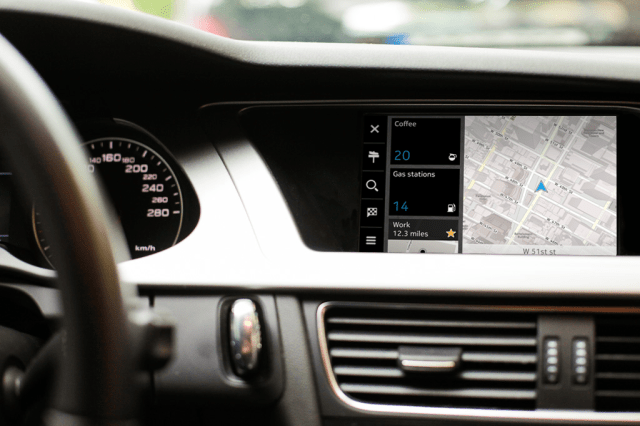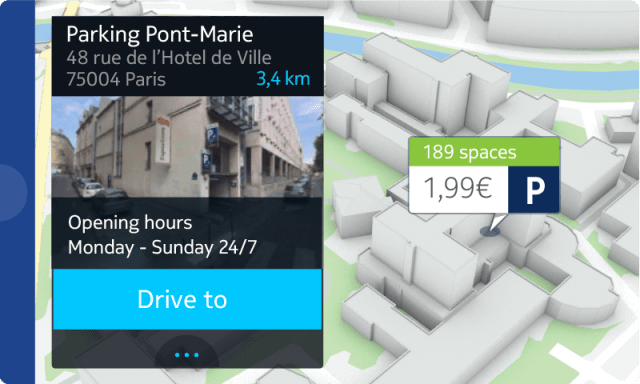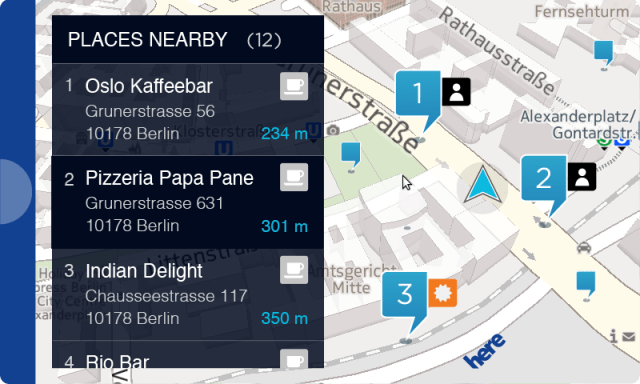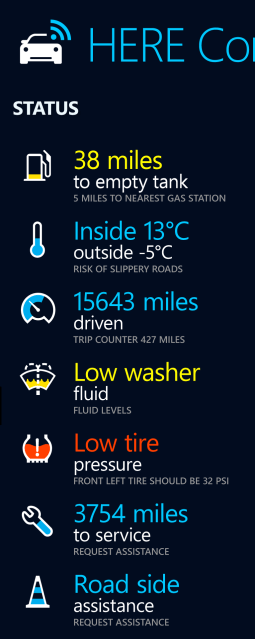
While Nokia continues to work on clawing back some of the once-market-leading smartphone business it has lost in the last few years to Apple and Android handset makers like Samsung, it has also slowly been building out a business based around its mapping and navigation division, rebranded as HERE earlier this year. That strategy — which has seen deals with the likes of Toyota, Volkswagen, BMW and Garmin for its in-car navigation systems — is going into high gear today. Nokia is launching Connected Driving, which included HERE Auto for embedded in-car navigation; HERE Auto Cloud for extra services like real-time traffic updates; and HERE Auto Companion, apps that will make it seamless to link up location data that you want to use or that you’ve created in your car, with what you are doing when you are outside the car and using your smartphone instead. On top of this, it’s upgrading its HERE Traffic system with a new data processing engine called “Halo.”
The launch today, in some regards, represents one of Nokia’s biggest challenges yet: it’s pitching itself as an operating system provider for other hardware makers (car companies; in-car system makers) to use as the platform for new products. Call it Nokia’s Android strategy.
Nokia is announcing the new products today and will be unveiling this suite of services at the the International Motor Show in Frankfurt, Germany on September 10. As with the rest of the products in HERE, Nokia’s intention is for all of this to be interoperable with different smartphone platforms. What that will mean in theory is that while HERE Auto and Auto Cloud will be loaded on to in-car systems, the apps in the Auto Companion will be launched for multiple platforms, including iOS and Android. In practice, though, Floris van de Klashorst, VP of connected cars for HERE, tells me that it’s likely that we will see the first services to be built on the platform that Nokia itself uses for smartphones, Windows Phone.
A rundown of the new services:
HERE Auto. This is Nokia’s embedded in-car navigation service. Using cached content, Nokia says it’s the first on the market that provides comprehensive mapping data even when a user doesn’t have a data connection. This includes turn by turn voice guided navigation in 95 countries, as well as 2D, 3D and satellite map views, with street-level imagery. Van de Klashorst tells me that Nokia is now also working on an SDK (yet to be released publicly) that will let third parties integrate services directly into this experience. He pointedly tells me that this will not include ads, which users they have surveyed have said are too distracting in cars. But this doesn’t rule out placing markers, for example, for a particular pizza joint when you are driving by it looking for some Italian food. Other features that are likely to come in by way of the SDK are music services and social networking services (not distracting like ads at all, right?!). Early users of this before the wider release include in-car system maker Continental, which is using them as part of its “Open Infotainment Platform.” I’d expect other app makers and navigation service companies to be added to the list soon.
HERE Auto Cloud. Like HERE Auto, this is also designed to work with and without data connections — useful for when you are in remote areas, or you are in regions where you may be roaming outside of your carrier’s network. This is Nokia’s own layer of extra services around driving — for example real-time traffic updates, helping drivers avoid congested areas, road closures or blockages that occur en route, as well as other services such as recommendations on places to eat, parking spots, information on where to charge an electric vehicle or where to find the most inexpensive fuel.

From the screenshots that Nokia provided to me, it looks like this is one of the fruits of its relationship with Foursquare:

 HERE Auto Companion. This is the bridge between what Nokia is doing in the car and what it is doing outside of it. The Auto Companion, as Van de Klashorst demonstrated to me, works both on the web and as a mobile app, and it’s actually very cool: what it lets you do is create mapping instructions or take notes of a place that you’d like to visit, when you are sitting at your computer or on your phone, and then, when you get into your HERE-powered car, those data points follow you. If you start a trip in your car, and then park it, you can continue finding your way using your handset. Taking a page from the many apps that let users control what their TVs at home are recording, Nokia says that drivers can also use the app to find their car (using LiveSight augmented reality technology) and check stats for fuel levels and tire pressure. Part of this will be based on the new HALO platform, which basically will gather data using different sensors on the car. This will be used not just for app services for the consumer but to help gather more accurate information about weather in a particular place and more.
HERE Auto Companion. This is the bridge between what Nokia is doing in the car and what it is doing outside of it. The Auto Companion, as Van de Klashorst demonstrated to me, works both on the web and as a mobile app, and it’s actually very cool: what it lets you do is create mapping instructions or take notes of a place that you’d like to visit, when you are sitting at your computer or on your phone, and then, when you get into your HERE-powered car, those data points follow you. If you start a trip in your car, and then park it, you can continue finding your way using your handset. Taking a page from the many apps that let users control what their TVs at home are recording, Nokia says that drivers can also use the app to find their car (using LiveSight augmented reality technology) and check stats for fuel levels and tire pressure. Part of this will be based on the new HALO platform, which basically will gather data using different sensors on the car. This will be used not just for app services for the consumer but to help gather more accurate information about weather in a particular place and more.
For cars that are shared between more than one person (say, in a family) each user can have his or her own interface in a vehicle:
Van de Klashorst tells me that the big idea here is to personalize those in-car experiences: “One thing that is apparent is that people have a strong relationship both with their cars and with their phones, but the in-car systems are ice cold. People cannot influence or modify or personalise them. To make them personal is a very important aspect.”
And when you think about this, it’s a potentially interesting area when you link it up with wider trends in the automotive space, such as with car sharing services like Zipcar. “With car sharing services, this car that you don’t own becomes your car. Systems like this once will be a very important part of elevating and experience to make it your own,” he notes.
Apart from the challenges of competing against other smartphone players (including Google, Apple and BlackBerry) who also have stakes in the automotive game — Apple already has integrations with several car makers and there are often rumors swirling of how this will expand over time; Google has gone so far as to create self-driving vehicles; and BlackBerry has QNX — Nokia is doing this from a position that is not without its own challenges. In Nokia’s last quarterly earnings, Here posted sales of $305 million, down 18% over last year, up 8% on the previous quarter and it remains loss-making, with a $116 million operating deficit, which is at least marginally better than the $120 million a year ago. (A HERE representative points out, however, that the division has “underlying profitability” and “strong automotive sales,” showing that it’s following through on establishing financial independence from Nokia’s smartphone business.)
Still, Nokia has in its hands a very key asset: it holds one of the biggest databases of mapping information in the world, meaning it doesn’t need to rely on third parties for it. And even with its many layoffs, it still employs hundreds of engineers that are thinking of clever ways of using that to Nokia’s advantage. Nokia has nothing to lose by trying to get out into pole position in this space at this still-early stage in the connected car revolution.